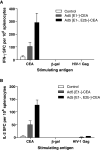Anti-tumor immunotherapy despite immunity to adenovirus using a novel adenoviral vector Ad5 [E1-, E2b-]-CEA
- PMID: 20361185
- PMCID: PMC11030277
- DOI: 10.1007/s00262-010-0847-8
Anti-tumor immunotherapy despite immunity to adenovirus using a novel adenoviral vector Ad5 [E1-, E2b-]-CEA
Abstract
Adenovirus serotype 5 (Ad5) has been widely used in clinical trials because it expresses inserted transgenes robustly and augments the innate immune response. Strategies to improve Ad5 vectors that can circumvent Ad5 immunity have become a critical issue, especially for use as a cancer immunotherapeutic in which repeated immunization is required. In this study, we constructed a novel Ad5 vector with unique deletions of the viral DNA polymerase and the pre-terminal protein region (Ad5 [E1-, E2b-]). This vector contains the carcinoembryonic antigen (CEA) gene insert and is designed to induce cell-mediated immunity (CMI) against the tumor-associated target. The CEA immunogenicity and in vivo anti-tumor effects of repeated immunizations with Ad5 [E1-, E2b-]-CEA compared with those observed with current generation Ad5 [E1-]-CEA were tested in Ad5 pre-immunized mice. We report that Ad5-immune mice immunized multiple times with Ad5 [E1-, E2b-]-CEA induced CEA-specific CMI responses that were significantly increased over those detected in Ad5-immune mice immunized multiple times with a current generation Ad5 [E1-]-CEA. Ad5 immune mice bearing CEA-expressing tumors that were treated with Ad5 [E1-, E2b-]-CEA had increased anti-tumor response as compared with Ad5 [E1-]-CEA treated mice. These results demonstrate that Ad5 [E1-, E2b-]-CEA can induce CMI immune responses which result in tumor growth inhibition despite the presence of pre-existing Ad5 immunity. Multiple re-immunizations using the same vector platform are now possible with the novel Ad5 [E1-, E2b-] platform.
Figures


Similar articles
-
The generation and analyses of a novel combination of recombinant adenovirus vaccines targeting three tumor antigens as an immunotherapeutic.Oncotarget. 2015 Oct 13;6(31):31344-59. doi: 10.18632/oncotarget.5181. Oncotarget. 2015. PMID: 26374823 Free PMC article.
-
Novel adenoviral vector induces T-cell responses despite anti-adenoviral neutralizing antibodies in colorectal cancer patients.Cancer Immunol Immunother. 2013 Aug;62(8):1293-301. doi: 10.1007/s00262-013-1400-3. Epub 2013 Apr 30. Cancer Immunol Immunother. 2013. PMID: 23624851 Free PMC article. Clinical Trial.
-
Optimization of vaccine responses with an E1, E2b and E3-deleted Ad5 vector circumvents pre-existing anti-vector immunity.Cancer Gene Ther. 2009 Sep;16(9):673-82. doi: 10.1038/cgt.2009.17. Epub 2009 Feb 20. Cancer Gene Ther. 2009. PMID: 19229288 Free PMC article.
-
Mouse models expressing human carcinoembryonic antigen (CEA) as a transgene: evaluation of CEA-based cancer vaccines.Mutat Res. 2005 Aug 25;576(1-2):132-54. doi: 10.1016/j.mrfmmm.2004.10.014. Mutat Res. 2005. PMID: 15888344 Free PMC article. Review.
-
The influence of innate and pre-existing immunity on adenovirus therapy.J Cell Biochem. 2009 Nov 1;108(4):778-90. doi: 10.1002/jcb.22328. J Cell Biochem. 2009. PMID: 19711370 Free PMC article. Review.
Cited by
-
Extended evaluation of a phase 1/2 trial on dosing, safety, immunogenicity, and overall survival after immunizations with an advanced-generation Ad5 [E1-, E2b-]-CEA(6D) vaccine in late-stage colorectal cancer.Cancer Immunol Immunother. 2015 Aug;64(8):977-87. doi: 10.1007/s00262-015-1706-4. Epub 2015 May 9. Cancer Immunol Immunother. 2015. PMID: 25956394 Free PMC article. Clinical Trial.
-
Colorectal cancer vaccines: The current scenario and future prospects.Front Immunol. 2022 Aug 3;13:942235. doi: 10.3389/fimmu.2022.942235. eCollection 2022. Front Immunol. 2022. PMID: 35990683 Free PMC article. Review.
-
Improved cytotoxic T-lymphocyte immune responses to a tumor antigen by vaccines co-expressing the SLAM-associated adaptor EAT-2.Cancer Gene Ther. 2013 Oct;20(10):564-75. doi: 10.1038/cgt.2013.53. Epub 2013 Aug 16. Cancer Gene Ther. 2013. PMID: 23949283 Free PMC article.
-
Novel Concepts for HIV Vaccine Vector Design.mSphere. 2017 Dec 6;2(6):e00415-17. doi: 10.1128/mSphere.00415-17. eCollection 2017 Nov-Dec. mSphere. 2017. PMID: 29242831 Free PMC article. Review.
-
The generation and analyses of a novel combination of recombinant adenovirus vaccines targeting three tumor antigens as an immunotherapeutic.Oncotarget. 2015 Oct 13;6(31):31344-59. doi: 10.18632/oncotarget.5181. Oncotarget. 2015. PMID: 26374823 Free PMC article.
References
-
- Kirk CJ, Hartigan-O’Connor D, Mule JJ. The dynamics of the T-cell antitumor response: chemokine-secreting dendritic cells can prime tumor-reactive T cells extranodally. Cancer Res. 2001;61:8794–8802. - PubMed
-
- Kirk CJ, Hartigan-O’Connor D, Nickoloff BJ, Chamberlain JS, Giedlin M, Aukerman L, Mule JJ. T cell-dependant antitumor immunity mediated by secondary lymphoid tissue chemokine; augmentation of dendritic cell-based immunotherapy. Cancer Res. 2001;61:2062–2070. - PubMed
-
- Polo JM, Dubensky TW. Virus-based vectors for human vaccine applications. Drug Discov Today. 2002;1:53–100. - PubMed
-
- Gaydos CA, Gaydos JC. Adenovirus vaccine. In: Orenstein WA, editor. Vaccines. 4. Philadelphia: Sauders; 2004. pp. 863–885.
Publication types
MeSH terms
Substances
Grants and funding
LinkOut - more resources
Full Text Sources
Other Literature Sources

